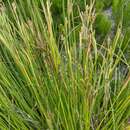Comprehensive Description
provided by North American Flora
Carex hindsii C. B. Clarke, Kew Bull. Add. Ser 8: 70 (excluding Montana specimen). 1908.
Carex decidua Boott, 111. Carex 163. 1858. (As to North American plant, not as to type.)
"Carex vulgaris Fries" Holm, Am. Jour. Sci. IV. 10: 269. 1900.
"Carex interrupta Bock." Holm, Am. Jour. Sci. IV. 10: 269. 1900.
Carex vulgaris var. limnophila Holm, Am. Jour. Sci. IV. 17: 307. 1904. (Type from St. Paul Island, Bering Sea.)
Carex vulgaris var. lipocarpa Holm, Am. Jour. Sci. IV. 17: 308. 1904. (Type not definitely designated.)
Carex Goodenovii var. limnophila M. E. Jones, Bull. Univ. Mont. 61: 72. 1910. (Based on C. vulgaris var. limnophila Holm.)
Carex Goodenovii var. lipocarpa M. E. Jones, Bull. Univ. Mont. 61: 72, in part. 1910. (Based on C. vulgaris var. lipocarpa Holm.)
Cespitose, forming medium-sized or large clumps, the rootstocks short to long, stout, tough, branching, creeping and descending, often fibrillose, the culms 1-5 dm. high, slender but strict, sharply triangular, papillose, smooth or slightly roughened above, shorter than or often exceeded by the leaves, phyllopodic, brown or purplish-brown at base, the dried-up leaves of the previous year conspicuous; sterile shoots aphyllopodic; leaves with well-developed blades 5-10 to a fertile culm, clustered on lower third, the blades erect, thin, firm, light-green, flat above, channeled towards base, usually 1.5-3 dm. long, 1.5-3 mm. wide, long-attenuate, much roughened towards the apex, the sheaths obscurely or not at all septate-nodulose dorsally, not hispidulous, thin-white-hyaline and yellowish-brown-dotted ventrally, concave at mouth (often deeply so), the ligule as wide as long; staminate spike solitary, short-peduncled or nearly sessile, linear, 1.5-3.5 cm. long, 2.5-4.5 mm. wide, the scales oblong-obovate, very obtuse, purplish-black with broad lighter center and white-hyaline margins; pistillate spikes 3-6, more or less strongly separate or the upper approximate, linear, 1-4.5 cm. (typically 2-3.5 cm.) long, 5-7 mm. wide, erect, the lower short-peduncled, the upper sessile or nearly so, densely flowered, with numerous appressed-ascending perigynia in several to many rows; lowest bract leaf-like, strongly exceeding inflorescence, sheathless or nearly so, the upper reduced, biauriculate; scales oblong-oblanceolate or oblong-lanceolate, obtuse or acutish, purplishblack with narrow or broad lighter center not extending to the apex, hyaline apex and upper margins, much shorter than and about half the width of perigynia, early deciduous; perigynia early deciduous, ovate, strongly flattened, unequally biconvex, 2-edged, 2-3.5 mm. long, 1.5-2 mm. wide, membranaceous, slenderly about 5-ribbed on both sides, yellowish-green, papillate, rounded or truncate and strongly (0.5-1 mm.) slenderly stipitate at base, tapering or contracted into an apiculate, subentire, usually black-tipped beak, the beak 0.1-0.25 mm. long; achenes lenticular, suborbicular, 1.5 mm. long and about as wide, filling lower two thirds of perigynium, brownish-black, granular, substipitate, abruptly short-apiculate, jointed with the short slender style; stigmas 2, reddish-brown, slender.
Type locality: Columbia River {Hinds).
Distribution: Wet meadows along the coast, from northwestern California to the Aleutian and Commander Islands; abundant on the Alaskan coast. (Specimens examined from northwestern California, Oregon, Washington, British Columbia, including Vancouver Island, Alaska.)
- bibliographic citation
- Kenneth Kent Mackenzie. 1935. (POALES); CYPERACEAE; CARICEAE. North American flora. vol 18(6). New York Botanical Garden, New York, NY

